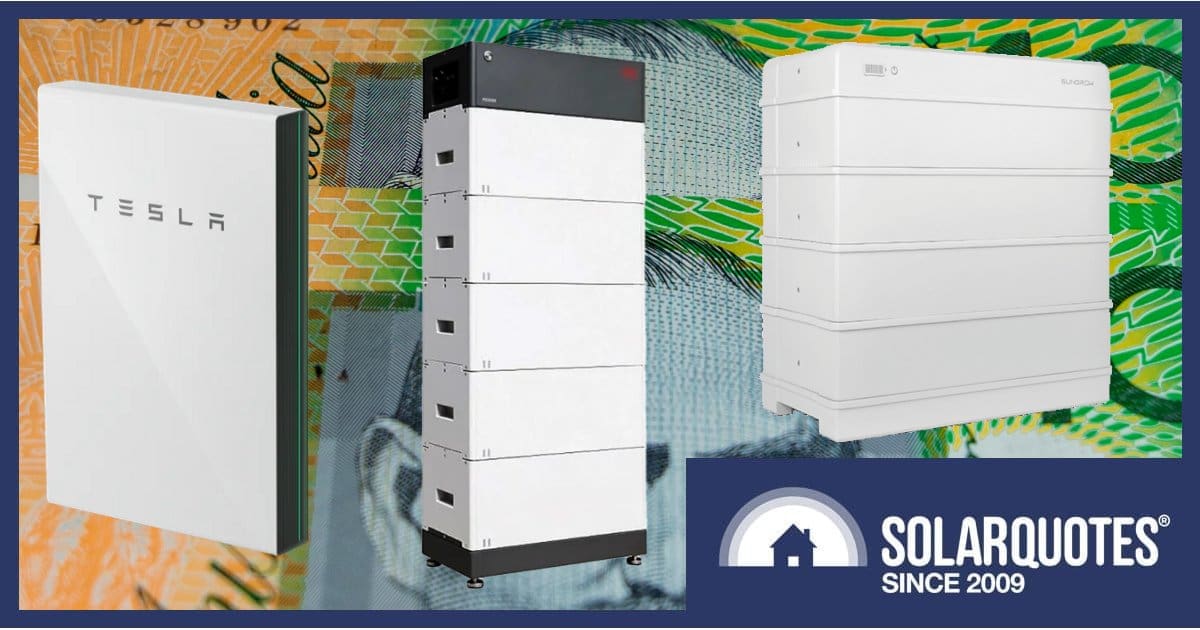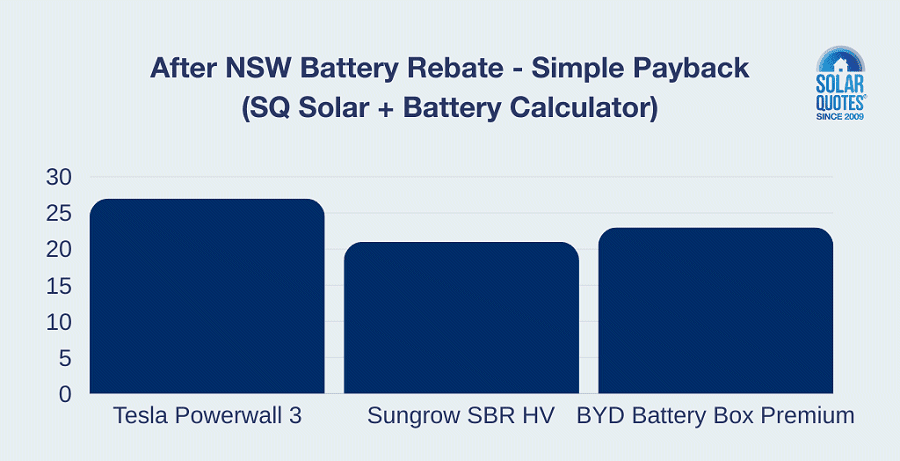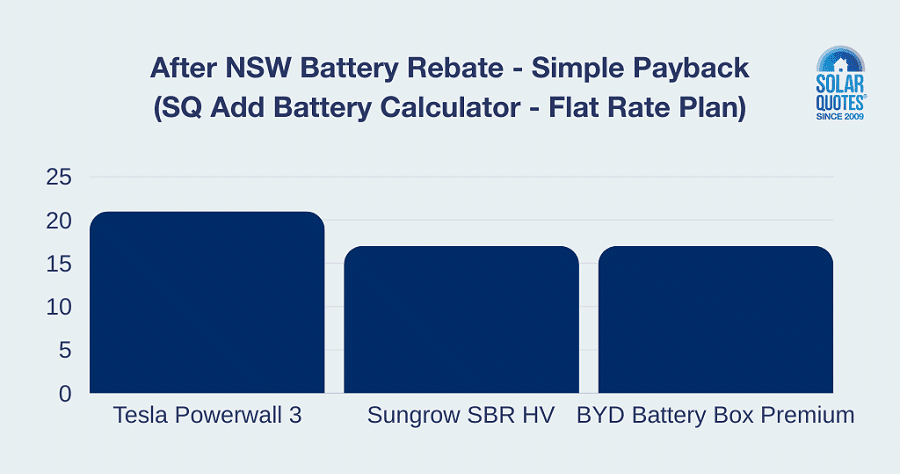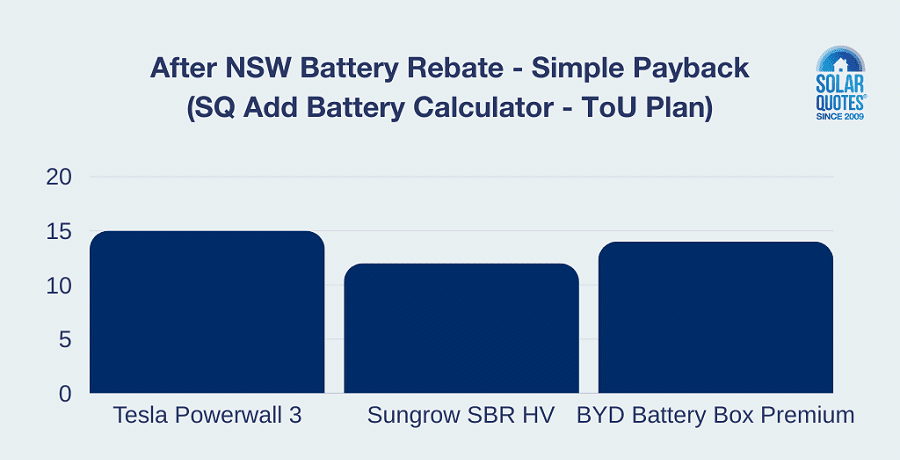
New South Wales’ battery rebate can knock thousands off the cost of a home energy storage system. So, how does that impact simple payback?
If you aren’t familiar with the NSW incentive, in a nutshell it involves PDRS certificates (PRCs) that have a value, which can vary according to market conditions. After any admin fees, the total value of these certificates is offered as an up-front discount to the battery purchaser. Check out our recently updated NSW battery rebate information page to get some more background on how it works.
Calculating Estimated Payback
For the purposes of this exercise, we’ll look at three batteries – the Tesla Powerwall 3 (13.5kWh usable capacity), Sungrow’s SBR HV (12.8 kWh model) and the BYD Battery Box Premium HVM (13.8 kWh).
In case you want to play along at home, this is how I’ll go about it the first time around.
- I’ll use the SolarQuotes NSW battery rebate calculator to estimate how much the rebate will be based on a postcode of 2750 and a new battery installation.
- Then using SQ’s solar + battery calculator with its default values – aside from specifying a 2750 postcode and subtracting the rebate from the battery system cost noted in that calculator – it will provide a rough estimate of payback time (it will show separate payback periods for the two in the results).
Note that the solar + battery calculator will also have a 6.6kW solar power system selected by default. I’m going to leave that as is.
So, here we go – the results:
- A Tesla Powerwall 3 attracts 1,088 PRCs. At a rate of $2.00 per PRC, this gives a base rebate of $2,176. With the incentive subtracted from the estimated supply and installation cost; it works out to $14,424 and the battery’s simple payback is 27 years.
- The Sungrow SBR HV 12.8 is eligible for 1,031 PRCs. At $2.00 per PRC, this means a base rebate of $2,062. After the incentive, the estimated cost of supply and installation is $10,438 and simple payback for the battery is 21 years.
- BYD’s Battery Box Premium HVM 13.8 attracts 1,112 PRCs, for a base subsidy of $2,224 at $2.00/PRC. After the subsidy, the estimated cost of supply and installation is $11,376 and simple payback is 23 years.
Not Great, Right? But Wait …
Based on the calculator’s default settings, in each instance the battery payback is far, far longer than the warranties – even after the New South Wales incentive. But try it with your own details and battery of choice and you’ll likely get a much different (and hopefully much shorter) simple payback result given variables such as:
- Your location.
- How big your solar system is.
- The battery you choose (and what you’ll pay).
- What you pay for electricity and how much you use.
- PRC value.
For More Accurate Payback Results
Given all the variables, a much more accurate way to go about it is with SQ’s “add battery” calculator, which is specifically designed for adding a battery to an existing solar system. Other major points of difference include support for time-of-use as well as flat-rate electricity plans, and it requires you to upload what’s called an NEM12 data file. This is a file that contains electricity consumption/export data and other metering information for your property. If you have a smart meter, you *should* be able get hold of your NEM12 file – here’s how. (it’s worth the effort).
I uploaded my NEM file (BTW, I have a 10kW solar system) and here are the results:
- Tesla Powerwall 3: 21 years
- Sungrow SBR HV 12.8: 17 years
- BYD’s Battery Box Premium HVM 13.8: 17 years
These results were based on an EnergyAustralia flat rate plan available in postcode 2750. It appears EA doesn’t have a time-of-use (ToU) offer for that area according to their website. The best electricity plan for solar + battery owners is often ToU with lower off-peak and shoulder rates. While time-of-use plans have expensive peak rates, these can be mostly avoided if you have enough solar and storage.
Under an EA ToU plan (and I’m not suggesting EA’s are the best plans available), simple payback for me looks like so:
- Tesla Powerwall 3: 15 years
- Sungrow SBR HV 12.8: 12 years
- BYD’s Battery Box Premium HVM 13.8: 14 years
That’s looking better, but still longer than the 10-year warranties. Again, your own results will very likely be different to mine.
Don’t Forget VPP Incentives
The NSW incentive provides extra subsidies when the battery will be connected to a Virtual Power Plant – there’s a box you can tick on the NSW rebate calculator indicating this. VPP incentives can also be claimed for eligible existing batteries. In the above examples (new installations):
- Tesla Powerwall 3: an additional 165 PRCs, increasing your incentive amount by $330.
- Sungrow SBR HV 12.8: an additional 156 PRCs, increasing the incentive by $312.
- BYD Battery Box Premium HVM 13.8: additional 168 PRCs, increasing the subsidy by $336.
.. which will help accelerate payback further (plus there may be other VPP incentives) – as long as you don’t mind having a third-party taking control of your battery.
If a home battery purchase decision hinges on rapid payback, it may still not be for you – but you may place great value on other aspects, such as blackout protection. Learn everything you need to know about understanding, buying and owning home energy storage.




 RSS - Posts
RSS - Posts



I believe that the lack of battery systems being included in the federal STC system as applying to panels, is a serious shortcoming, and, in the time that it has left in this term of government, the federal parliament should be including battery systems in the STC system, at the same rate of subsidy as mentioned in the example above (for example, the subsidy of $2,224 for a BYD Battery Box Premium HVM 13.8, so, 2224/13.8=(approx)$161/kWh capacity), and, that subsidy, along with the STC subsidy for panels, should not decrease each year (or, otherwise decrease).
The benefits of this, across Australia, including, but not limited to, energy arbitrage, would be phenomenal.
Hi Brett,
It might be happy coincidence, but the STCs winding back at 7% per year has been pretty good. As the price of PV solar has fallen, the incentive has maintained affordability without ending up paying for whole systems of cheap rubbish like the last of the $8000 SHCP scheme did. There was a time when you could get *free* solar power systems… and it wasn’t good for quality.
Okay.
However, I still believe that the STC system should be extended to include BESS’s, as I have suggested.
The tealed senators are supposed to have put forward a (weak) suggestion to include BESS’s, but, then they apparently got bored with their proposition, and, abandoned it.
From the article
These results were based on an EnergyAustralia flat rate plan available in postcode 2750. It appears EA doesn’t have a time-of-use (ToU) offer for that area according to their website.
My experience of the EA website in my Sydney suburb is this:
a) If you just enter a postcode you only get presented with flat rate plans. If you try and buy one of those plans i.e. you enter your account details for a specific address you cannot buy, you are not permitted to buy, a given plan unless you have very old fashoined meter – despite the flat rate plan being shown by default.
b) If you enter an address you do get presented with ToU plans
c) Sit tight for this one:
EA offer ToU plans that have different rates for various times of day.
Some of these plans also have a discount applied to the peak, shoulder and off peak rates.
Some ToU plans do not attract a discount.
So far so good.
EA describes ToU plans that do not offer a discount as FLAT RATE plans despite stating Peak rate Xc – flat rate, shoulder rate Yc – flat rate, off-peak Zc flat rate.
So you’re saying that the electricity industry is making it difficult to the point of confusion, by failing to actually offer what they say on the tin?
Colour me surprised, sadly.
We were keen on taking advantage of this scheme and getting a battery to go with our current 8.2kw system. But after doing to sums it just isn’t worth it for us.
We spend around $1,000 on power each year and a bit over half of that is the supply charge, so at best we could save $500 per year, but on a $12.5k – $15k battery setup that’s 25-30 years for ROI.
This timeframe most likely decreases in the future as power prices increase, but unfortunately at the moment we can’t justify it.